Choosing how to introduce a new telehealth marketing plan may be a looming decision – but it doesn’t have to be. What people don’t realize is that the technology used in telehealth can be similar or identical to the technology we use in our day-to-day lives. When most people think of telehealth, they automatically think of video visits. They may not realize that telehealth can incorporate other communication channels like texting, calling, webchat, and more. All very familiar communication channels we use in our everyday lives.
Telehealth can also include a wide variety of technologies and services that health care professionals utilize to improve the entire health care delivery system. This may come in the form of non-clinical services, such as provider training, administrative meetings, and continuing medical education, in addition to clinical services.
Here are a few tips to consider when planning to launch a telemedicine marketing plan so you can educate and reach your patients more efficiently:
1. Prioritize the patient perspective
When deciding what features you would like to include in your new telehealth marketing plan, keep your patient base in mind.
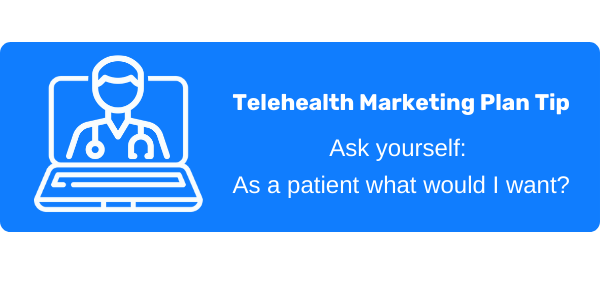
Consider questions like:
- Who are the patients that you are trying to reach?
- What are their needs?
- How can telehealth help to alleviate or solve your patients’ problems?
- Where can you align your best practices with your patients’ priorities?
If you are able to construct your telehealth protocols around what your patients value, you will be set up for a successful rollout.
2. Market the convenience of telehealth through educational content
People generally like to stick to what they are familiar with. In terms of seeking medical attention, this typically looks like a patient coming into the office and seeing the doctor in person. What many don’t realize is that telemedicine and virtual care can be far more convenient for a variety of reasons.
When compared to typical in-person appointments, telehealth appointments save time and money.
Patients don’t have to worry about driving to and from the practice, nor do they have to spend money on gas or public transportation to make it to their appointment. Especially for individuals who work, the time-saving potential of telehealth services visits is a huge draw-in.
Telehealth options also widen access to medical care for those who do not have the ability to make it to in-person appointments. Not only is this better for the health of the individual who is able to seek care virtually, it also benefits providers by allowing them to reach people that they otherwise wouldn’t be able to.
Ensuring that a key tenet of your telehealth marketing plan is education and the normalization of the telehealth experience and you’re sure to reap benefits for your organization.
3. Optimize the user experience
The goal of your telehealth marketing plan is to not only make healthcare more accessible to patients, but to also make them aware of their options.
In order for this to happen, the digital experience on a telehealth platform must be intuitive and efficient while maintaining personalization.
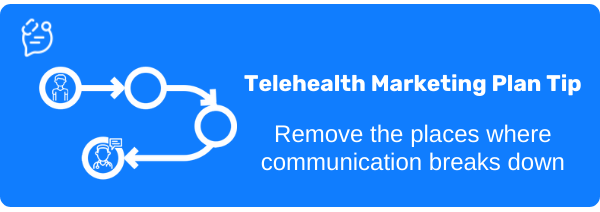
This means that on the journey from a first website visit, to scheduling an appointment, to filling out intake paperwork, the patient should find themselves clicking instinctively.
Highlighting ease of use should be key to your telehealth marketing plan. A streamlined experience will delight your patients.
4. Build trust in telehealth through patient success stories
There is truly nothing like a friend recommending a restaurant and finding that it actually lives up to the hype.
Patient success stories are essentially the restaurant recommendations of the medical field…but way more impactful.
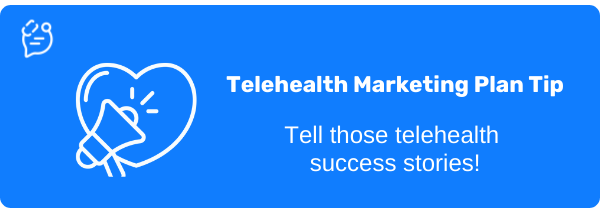
Patients may be nervous or skeptical of your new telehealth services, but citing the experiences of a few trustworthy patients to support your claims about the wonders of the telehealth visit may help to ease their anxiety. Telehealth success stories can also be used to bring in new patients who are interested in a positive telehealth experience.
5. Answer telehealth FAQs on your website
Successful promotion as part of your telehealth marketing plan is all about considering the patient’s point of view.
If your patients are not familiar with telehealth, hearing that your practice now offers this option could raise a lot of questions. Brainstorming some questions that your patients may have when learning about your new services will help to lighten your workload in the long run and will make your telemedicine practice feel approachable to your patients.
Try putting yourself in your patients shoes and consider what questions they may have about telehealth.
6. Notify current patients that you now offer telehealth services
We’ve seen many organizations successfully promote their telehealth offerings through digital means like email and online ads. You could also promote through more traditional routes like good ole’ snail mail.
Whatever route you choose, one thing remains true:
Informing current patients of your telehealth options is a sure-fire way to spark some interest.
Getting these options in front of your patients may prompt a visit to your website and may even bring some traffic to your new telehealth FAQ page.
7. Add a textable number to your website
Remember that video visits are only part of the telehealth puzzle.
The truth is there are many other tools you can utilize that will help you to deliver care outside the walls of your office that you could be including in your telehealth marketing plan.
The strong sentiment among most people lately is if you really want to reach me, text me. The odds of me picking up your phone call are slim to none.
In fact, 80% of people won’t pick up a call from an unknown number. A text message on the other hand? Texts get read 90% of the time and usually within the first three minutes of sending. So if you’re building a robust telehealth marketing plan, include HIPAA compliant texting as part of your mix and make sure people know you offer it!
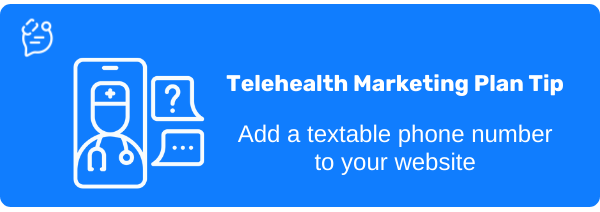
One very effective way to advertise your texting option is to put it front and center on your website.
You may decide to put a banner at the top of your website with the message “text us at {textable number}” so that patients have the highest chances of seeing it. Click here to see some examples of how other OhMD clients have shared their textable phone number.
8. Promote your telemedicine program on social media
If your practice has any social media accounts, it is a good idea to post about your new telehealth appointment options there.
Patients may be nervous or skeptical of your new telehealth services, but citing the experiences of a few trustworthy patients to support your claims about the wonders of the telehealth visit may help to ease their anxiety. Telehealth success stories can also be used to bring in new patients who are interested in a positive telehealth experience.
9. Add a prompt to your phone menu letting patients know they can text you instead
Some patients, prospective and current, may never visit your website before calling to schedule an appointment.
Staffing shortages are a huge issue for healthcare organizations around the country. A telehealth solution is the answer you’ve been looking for. Your telehealth program can help alleviate some of the headaches that come along with being short-staffed. It’s a simple fix that can save you time, energy and money.
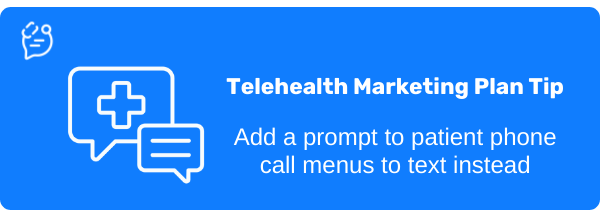
Utilize a HIPAA compliant texting service and give patients the option to text you rather than call. With a service like OhMD, you can easily add messaging to your answering service informing patients that they can hang up and instead text the same number. Be sure that they know that texting you is the quickest way to connect, schedule an appointment, or get a prescription refill.
An example of one of these messages could be:
“Hi, you’ve reached {practice name}. If you would prefer, you can text our office and avoid being put on hold. Feel free to hang up this call and text us at {office phone number}, and one of our team members will get back to you as soon as possible.”
Super simple. Super effective.
10. Make every interaction meaningful
This one is incredibly important, and yet something that is very often missed in a telehealth marketing plan.
Make sure that your patients know, even through a screen, that you care about them.
As you launch your telehealth marketing strategy, you need to continue to be sure that your patients are happy with your new services and will continue to utilize them.
Personalizing care, in-person or through telehealth, doesn’t need to be complicated. Sincere connection and authentic communication can go a long way. Remembering to ask about your patients’ family members, their new job, or their favorite hobbies can show that you have a genuine interest in their life and wellbeing.
Visiting a doctor should be less like seeing a stranger and more like seeing an old friend. A well executed telehealth marketing plan can help to make that a reality.



